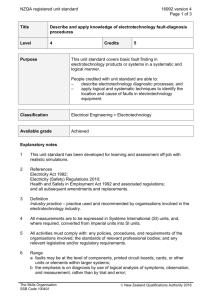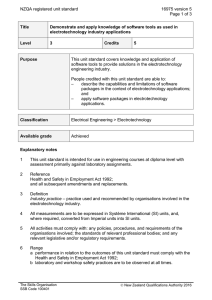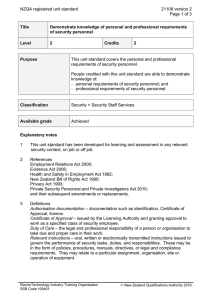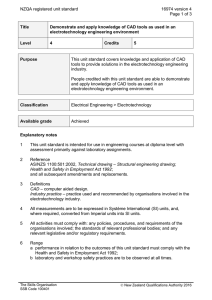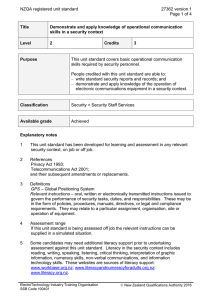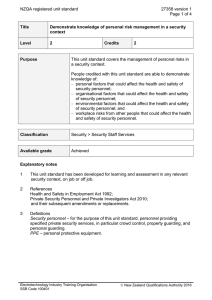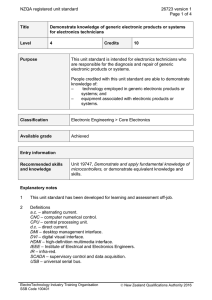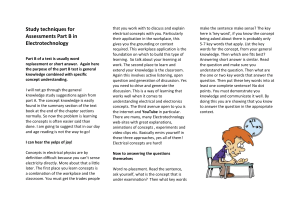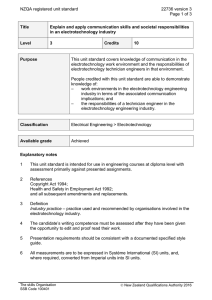NZQA registered unit standard 17495 version 3 Page 1 of 5
advertisement
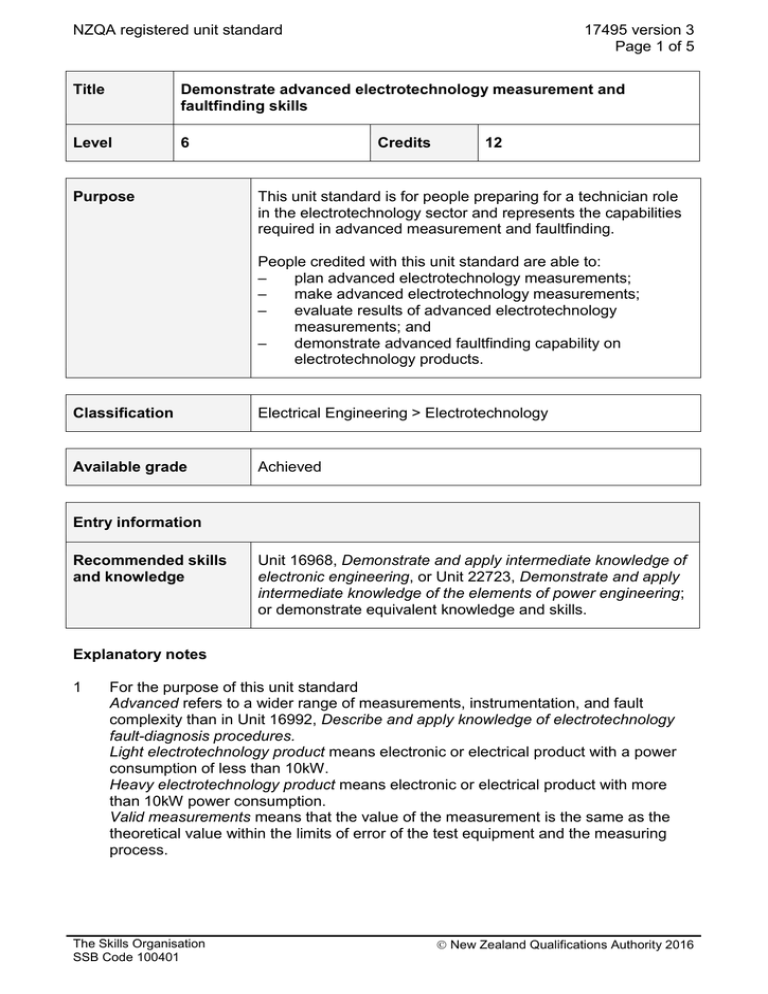
NZQA registered unit standard 17495 version 3 Page 1 of 5 Title Demonstrate advanced electrotechnology measurement and faultfinding skills Level 6 Purpose Credits 12 This unit standard is for people preparing for a technician role in the electrotechnology sector and represents the capabilities required in advanced measurement and faultfinding. People credited with this unit standard are able to: – plan advanced electrotechnology measurements; – make advanced electrotechnology measurements; – evaluate results of advanced electrotechnology measurements; and – demonstrate advanced faultfinding capability on electrotechnology products. Classification Electrical Engineering > Electrotechnology Available grade Achieved Entry information Recommended skills and knowledge Unit 16968, Demonstrate and apply intermediate knowledge of electronic engineering, or Unit 22723, Demonstrate and apply intermediate knowledge of the elements of power engineering; or demonstrate equivalent knowledge and skills. Explanatory notes 1 For the purpose of this unit standard Advanced refers to a wider range of measurements, instrumentation, and fault complexity than in Unit 16992, Describe and apply knowledge of electrotechnology fault-diagnosis procedures. Light electrotechnology product means electronic or electrical product with a power consumption of less than 10kW. Heavy electrotechnology product means electronic or electrical product with more than 10kW power consumption. Valid measurements means that the value of the measurement is the same as the theoretical value within the limits of error of the test equipment and the measuring process. The Skills Organisation SSB Code 100401 New Zealand Qualifications Authority 2016 NZQA registered unit standard 17495 version 3 Page 2 of 5 2 Evidence for the outcomes of this unit standard must be presented for the following: a Electrotechnologies - measurement of signal, logic, and power parameters in analogue, digital, single, and three phase technologies. b Product type - either light electrotechnology products, for example, a computer system, programmable logic control system (PLC) for a single process, telephone switchboard, or professional radio receiver; or heavy electrotechnology products, for example, factory generation system, components for national grid, industrial electric motor and controller; or equivalent. c Measurements - includes standard measurements for the product category in terms of power off, power on, and operational performance checks; and more complex measurements using supplied or derived information. d Measurement equipment - the free selection and usage of common measuring equipment including meters, oscilloscopes, function generators; or specialised equipment such as spectrum analysers, logic analysers or protocol analysers for which set up and operational instructions are supplied. e Fault complexity - at least two of the following; prototype and established product with non-operational, sub-optimal performance, or intermittent fault problems. 3 The following apply to the performance of all outcomes of this unit standard a All measurements are to be expressed in Système International (SI) units, and, where required, converted from Imperial units into SI units. b All activities must comply with: any policies, procedures, and requirements of the organisations involved; the ethical codes and standards of relevant professional bodies; and any relevant cultural legislative and/or regulatory requirements, which can include but are not limited to: the Treaty of Waitangi, the Health and Safety in Employment Act 1992, the Electricity Act 1992, and all subsequent amendments. Outcomes and evidence requirements Outcome 1 Plan advanced electrotechnology measurements. Evidence requirements 1.1 The measurement plan fulfils the measurement requirement. Range 1.2 The choice of measuring equipment has the capability of meeting the measurement requirement. Range 1.3 plan includes – scope, type, method, volume, accuracy of measurements. measurement range, measurement accuracy, potential effect on item to be measured. The logistics of the plan are practical for the measurement requirement. Range The Skills Organisation SSB Code 100401 includes – time availability, equipment availability, optimum choice of method for constraints present. New Zealand Qualifications Authority 2016 NZQA registered unit standard 17495 version 3 Page 3 of 5 Outcome 2 Make advanced electrotechnology measurements. Evidence requirements 2.1 The setup and use of measuring equipment comply with site safety standards. 2.2 Calibration and use of equipment enable valid measurements to be obtained. 2.3 The measurement process does not affect the measuring equipment or the measured item. Range 2.4 not exceeding measuring equipment range, or affecting measured item's operation and performance. Choice of measurements are sufficient to offset effects of measurement error. Range choice includes – volume, repetition, correlation, statistical approaches. Outcome 3 Evaluate results of advanced electrotechnology measurements. Evidence requirements 3.1 The evaluation presents the results in a format which can verify their authenticity. Range 3.2 format includes any of – graphical, statistical or logical methods. The evaluation identifies the significance of the results in terms of different factors. Range factors include – performance confirmation and anomalies, measurement anomalies, measurement equipment, method limitations. Outcome 4 Demonstrate advanced faultfinding capability on electrotechnology products. Evidence requirements 4.1 The process demonstrates the logical application of faultfinding activities. Range The Skills Organisation SSB Code 100401 activities include – division of faulty item into subsystems, stage by stage analysis, use of block diagrams, flow charts, faultfinding trees. New Zealand Qualifications Authority 2016 NZQA registered unit standard 4.2 Each step in the process is derived from valid comparison of the diagnostic evidence with the expected results of the given electrotechnology application. evidence includes – deduction and measurement evidence, comparison with known good examples. Range 4.3 17495 version 3 Page 4 of 5 The integrity of the product is not affected by the diagnostic process. integrity includes – structure, operation, modification of performance. Range 4.4 The faultfinding results reflect analysis that explains the causes of malfunction in terms of the product electrotechnology. 4.5 The scope of repair strategy extends to circuitry or components that are affected both directly and indirectly by the fault conditions. Replacement information This unit standard replaced unit standard 11560. Planned review date 31 December 2014 Status information and last date for assessment for superseded versions Process Version Date Last Date for Assessment Registration 1 27 April 2000 N/A Rollover and Revision 2 15 March 2012 N/A Revision 3 15 January 2014 N/A Consent and Moderation Requirements (CMR) reference 0003 This CMR can be accessed at http://www.nzqa.govt.nz/framework/search/index.do. Please note Providers must be granted consent to assess against standards (accredited) by NZQA, before they can report credits from assessment against unit standards or deliver courses of study leading to that assessment. Industry Training Organisations must be granted consent to assess against standards by NZQA before they can register credits from assessment against unit standards. Providers and Industry Training Organisations, which have been granted consent and which are assessing against unit standards must engage with the moderation system that applies to those standards. The Skills Organisation SSB Code 100401 New Zealand Qualifications Authority 2016 NZQA registered unit standard 17495 version 3 Page 5 of 5 Requirements for consent to assess and an outline of the moderation system that applies to this standard are outlined in the Consent and Moderation Requirements (CMR). The CMR also includes useful information about special requirements for organisations wishing to develop education and training programmes, such as minimum qualifications for tutors and assessors, and special resource requirements. Comments on this unit standard Please contact The Skills Organisation reviewcomments@skills.org.nz if you wish to suggest changes to the content of this unit standard. The Skills Organisation SSB Code 100401 New Zealand Qualifications Authority 2016
